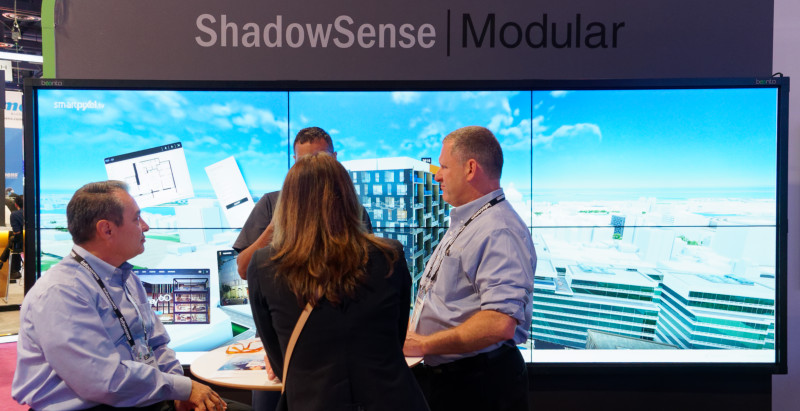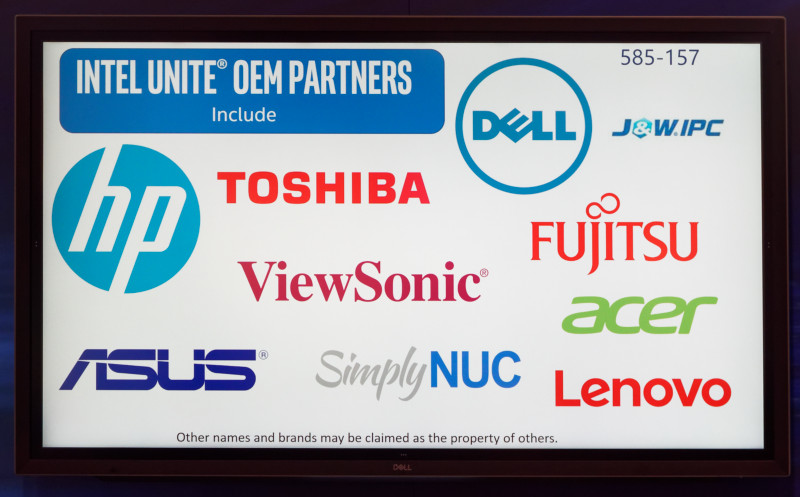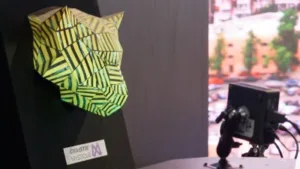Avocor has slight differences in its product range in US and Europe. The company told us that Microsoft was promoting its displays at the show as now that the original Surface Hub has stopped shipping, the company’s top of the range Windows-integrated system is a credible alternative. (We went to talk to Microsoft to confirm this, but they had ‘nobody qualified to talk to the press’ and prevented demonstrating staff from talking to us!)
The company has lower cost options, these days, but they still support UltraHD and have bonded displays. Avocor was also showing its cloud platform in prototype form.
Baanto, the developer of optical touch, was collaborating with Optika Display (owned by Stratacache) and the companies were showing a 3 x 2 array of 55″ bonded displays using Baanto’s ShadowSense touch technology.
 Baanto demonstrated a 3 x 2 array of displays from Optika. Image:Meko
Baanto demonstrated a 3 x 2 array of displays from Optika. Image:Meko
CleverTouch was showing its Pro Series which is available with a combined system of touch using IR and EMR in 65″, 75″ and 86″. The combination of the technologies is said to improve the writing experience and the main touch data comes from the infrared. The 86″ will sell for $9,187 in the US. The company highlighted its CMS which supports instant messaging and scheduling. The displays are based on Android 7, now, and can use NFC for profile and account login. The company said that the use of Android 7 means that the displays can be shut down remotely, which is useful if displays are accidentally left powered up.
There will be more developments and new products at ISE in 2019. CleverTouch supports Zoom collaboration and can allow custom home screens as well as supporting the use of QR codes to connect to meeting notes.
 Clevertouch highlighted the added value features of its displays. Image:Meko
Clevertouch highlighted the added value features of its displays. Image:Meko
DaLite had an impressive demonstration of its latest Parallax Thin 23 ambient light rejecting projection screens which have a half angle of 23 deg, gain of 2.3 and can absorb 96% of ambient light. The conditions were very difficult for projection (intentionally) but contrast was very good. The technology can be provided in sizes up to 120″ and that size has an MSRP of $4,482.
DaLite has also started to sell and stock standard products in its Descender Pro range, whereas before the company has always made to order. The company believes othat this will help to drive its sales as it will be able to offer same day shipment from stock in 16:9 and 16:10 formats from 106″ – 164″ diagonals and with four different surfaces – HD Progressive 0.9, HD Progressive 1.1, Da-Mat and Matte White. The black drop for tensioned screens will be 12” visible and preset while the black drop for the non-tensioned will be 2” visible and preset with a total 12” built into the housing.
FlatFrog goes from strength to strength and was showing a range of displays from a range of makers that use its technology. It was showing the new Avocor F Line and new ViewSonic displays in 65″ and 75″ which should ship in July. The company continues to work on its whiteboard software and has other plans to develop beyond its core optical technology. Optika also said that it had a couple of displays on the booth, but we didn’t get a note of that. There was a Trutouch X9 from Newline which is optically bonded.
Of course, one of the big wins for FlatFrog has been Samsung’s Flip.
Intel was at the show to promote its Unite platform which has continued to gain partners. The company is expanding the platform into education where Intel told us it is very popular partly because it is simple to use and requires no training. It also needs no software licence. Intel also said that had added seven new OPS partners – Advantech, Axiomtek, Centerm, Edge I&D, J&W IPC, Honghe and ViewSonic. It also has support for the VP10 codec.
The company was demonstrating the FlatFrog whiteboarding plug-in for the platform and Intel has also developed a plug-in for Skype for Business and also supports Cisco and Webex. The company has been developing its integration with ActiveDirectory. The FlatFrog app is seen as the premium whiteboard functionality, with a plug-in for Scratchpad being seen as a simple option.
Connections to Unite-enabled displays can support Apple via Airplay and Android via Miracast.
An unusual feature is an ultrasonic-based joining system which avoids the need for PINs. The company is also working to improve its touch performance.
 Intel has increased its partners (others include Zoom, FlatFrog, Nureva and Avocor). Image:Meko
Intel has increased its partners (others include Zoom, FlatFrog, Nureva and Avocor). Image:Meko
IRTouch was showing its HD series which has developed its infrared technology to use a new mechanical design that has lower depth and width and can support displays up to 86″. The bezel is smaller and looks good and also reduces the contact height – the height above the display where the touch is triggered. A smaller distance improves touch reliability. Although the company can support more, it sees 10 as the optimum number of touch points. Video walls can be supported at up to 40 points, but with 20 points, writing recognition gets worse.
Finished products using the technology are expected to be seen at ISE in February.
 IRTouch has reduced the height and width of its infrared surround. Image:Meko
IRTouch has reduced the height and width of its infrared surround. Image:Meko
Ricoh took us around its booth and avoided talking too much about its products, but highlighed to us that it has developed a new service that can immediately connect a user of one of its collaboration displays (from 22″ to 84″) to a help line. This is to get over some of the problems that users can have with collaboration displays. Ricoh also has meeting management support software. The service is provided free of charge for the first 60 days after purchase but costs $199 per year after that.
 Ricoh was highlighting its support services. Image:Meko
Ricoh was highlighting its support services. Image:Meko
Sharp was emphasising its collaboration products under the ‘Working Together’ tagline. As we have seen from the company, it is trying to develop its solutions for smaller meetings and signage audiences. Of course, as part of the Foxconn empire, Sharp is very involved in developing 8K solutions and was showing a 280″ video wall using sixteen 70″ video wall displays, previously shown at NAB. These were FullHD displays, of course, the PN-V701 but the company also plans an 8K 70″ display that will ship in the US in Q3 and will probably sell for around $13,000 and was again shown at NAB.
 Sharp was showing its 8K video wall and will introduce a 70″ 8K display. Image:Meko
Sharp was showing its 8K video wall and will introduce a 70″ 8K display. Image:Meko
A ‘preview product’ was a 40″ FullHD monitor that is 10mm thick at its thinnest (21mm at the thickest) and is lightweight so is said to be very simple to install and ship.
Sharp has been working on its collaborative displays and while it previously tended to work on a more closed ecosystem, it is trying now to develop wider support and was showing the use of Microsoft Whiteboard software, Office 365/Teams and Skype for Business. The company was highlighting the directional mic array and the direct bonded PCap display, which has low parallax and the Sharp ‘Pen on Paper’ effect surface. There are also sensors to detect, for example, the temperature so that HVAC systems can be controlled. The company has had 60″ and 70″ UlraHD products so far, but intends to add an 80″ version in July.
The company also told us that its SoC solutions are gaining more support, with 18 CMS providers now shipping products compatible with the displays.
A large number of companies were very enthusiastic about now having support for Zoom, so we talked to the company about why it seemed to have such a ‘buzz’. The company is relatively new and was founded by one of the original Webex developers. The developer felt that the original architecture needed replacing with something more modern and went to the management (the company is now owned by Cisco). Management was not keen on this, so he split out and started Zoom.
The Zoom collaboration products work with existing services such as LifeSize, Crestron and Polycom etc. and includes instant messaging and presence without cost. The technology gives priority to audio, but also allows video and data sharing. When a remote worker has a poor quality connection, the audio is the last part of the connection to be downgraded.

